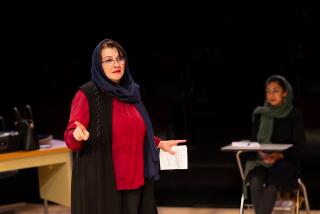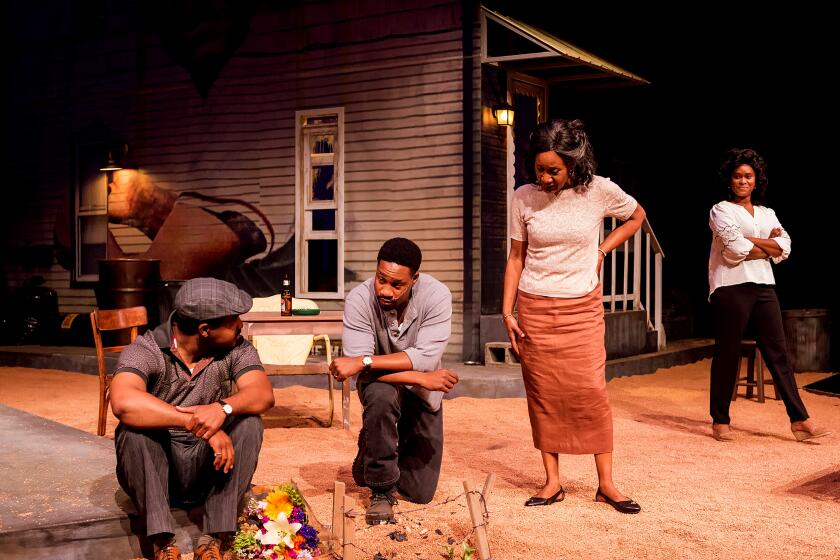Obie-winning playwright María Irene Fornés, a transformative off-Broadway figure, dies at 88
María Irene Fornés, the groundbreaking Cuban-born playwright who was a pivotal figure in the off-off-Broadway movement, died Tuesday at 88 after a long battle with Alzheimer’s disease.
Michelle Memran, the director of the 2018 documentary about Fornés, “The Rest I Make Up,” and part of the network of artists and friends who were staunchly by her side during her more than 12 years in care facilities, confirmed her death.
Arguably the most influential American dramatist whose work hasn’t become a staple of the mainstream repertoire, Fornés, a nine-time Obie winner, carved a special niche in the American theater. Although she was not as well-known as fellow theater maverick Sam Shepard, her playwriting exerted a similar magnetic pull on generations of theater artists inspired by her liberating example.
Admired by academics, her profoundly original and deeply humane plays are regularly taught in seminars on political, feminist, queer and experimental theater. But Fornés can’t be consigned to the university corner of specialized syllabi. Indeed, no survey of 20th century American drama would be complete without a sample of her work.
“Fefu and Her Friends,” her best-known play (first produced in 1977) and a landmark of feminist playwriting, is as interesting formally as it is politically and psychology. “Mud” and “The Conduct of Life,” her two masterpieces from the 1980s, scrubbed sociology to its theatrical essence. Her early works from the 1960s, such as “The Successful Life of 3” and the musical “Promenade,” caper with absurdist energy. Later works grapple with AIDS (“Enter the Night”) and the culture she left behind that was always with her (“Letters From Cuba”).
Born in Havana in 1930, Fornés immigrated to the U.S. with her mother and a sister in 1945 after the death of her father. They settled in New York. and she became a naturalized U.S. citizen in 1951. Gifted in the visual arts and design and possessing only a piecemeal formal education, Fornés initially set her sights on becoming a painter.
She studied with the abstract impressionist Hans Hofmann and traveled for a few years in Europe, where she saw Roger Blin’s original production of Samuel Beckett’s “Waiting for Godot” in Paris, a watershed experience for her.
As Fornés told the Village Voice’s Ross Wetzsteon, “I didn’t speak any French at all. But I understood the world in which it took place, I got the rhythm. And it turned my life upside down.”
Still figuring out her path when she returned to New York, Fornés fell into writing by trying to help her lover, Susan Sontag, then a philosophy instructor at Columbia, get started on a novel.
“I had all this creative energy that I had to use,” Fornés recalled. “I never really loved painting. Still, I might never have even thought of writing if I hadn’t pretended I was going to show Susan how easy it was.”
“Tango Palace,” Fornés’ first play, premiered at the Actor’s Workshop in San Francisco in 1963 under the direction of Herbert Blau. With her roots firmly planted in New York’s burgeoning off-off-Broadway scene, Fornés would go on to write more than 40 plays that would rewrite the rules of the American theater.
In the preface to a collection of Fornés’ plays, Sontag describes her former partner as “a writer of bicultural inspiration, one very American way of being a writer,” and an “autodidact whose principal influences were neither theatre nor literature but certain styles of painting and the movies.”
Fornes’ writing can be disarmingly direct. “Her language is like that real thin crystal that, when you pour a drink, you’re afraid the glass will crush from the weight of the liquor,” playwright Harvey Fierstein told critic Don Shewey.
The plays, often centered on female characters longing for the education and enlightenment they hope will lead to a less constricted existence, unfold as a series of tableaux whose simplicity belies their emotional power. Scenes are distilled, and spatial composition takes precedence over conventional plot. The playwright’s social conscience is expressed not in prescriptive answers but in an abiding interest in characters historically relegated to the voiceless margins.
“Most critics and theatergoers,” Fornés told New York magazine in 1985, “are so used to seeing plays in only one way — What is the dramatic conflict? What are the symbols? — that they go through their entire lives looking for the same things. If they don’t find what they expect, they’re disconcerted. But I can’t ‘plant’ things that way, like a treasure hunt where you need a map. To me a play is more like a path I just follow, never knowing where it’s going to end up, letting the material guide me step by step.”
There are many ways to bungle Fornés path-breaking plays in performance so, to realize her dramatic vision in three dimensions, she became an accomplished director. Exploratory in her directorial methods yet always firmly in control, she made full use of her visual arts background as she collaborated closely with designers on premieres of her own plays and on occasional productions of classics.
Every element of the staging, including the acting, was arranged to strip the habits of conventional perception so that life, both theatrical and societal, could be seen anew. The trademark naivety of Fornés’ characters was matched by a production style that understood just how profound stillness, sparseness and playful humor could be.
These qualities were freshly reinvented each time Fornés’ sat down to write a play. Her oeuvre is remarkably diverse. Her signature was her freedom from having a signature.
Commercial success wasn’t in the cards for Fornés as it was for her male off-off-Broadway peers Shepard and Lanford Wilson, both of whom revered her. Broadway, with its rigid rehearsal procedures and staid expectations, was antithetical to all she stood for. But even prominent nonprofit theaters across the country had trouble accommodating an artist who cared more about collective process than institutional hierarchies. The relative scarcity of her highly regarded work on our most visible stages is why it was so significant when New York’s Signature Theatre Company devoted its 1999-2000 season to her plays.
Off-off Broadway and fringe theaters throughout the land were Fornés’ natural home. If widespread fame was denied her, she was a totemic figure to many theater academics and artists. Tony Kushner was one of the many playwrights drawn to understand, as he put in a tribute essay, “the Fornés magic” — the way “politics, psychology, and formal experimentation cohabit in the house of Narrative Realism as if nothing were more natural.”
A celebrated playwriting teacher who served as director of INTAR’s Hispanic Playwrights in Residence Lab in New York and conducted workshops at theaters (including the Mark Taper Forum) and universities in the U.S. and abroad, Fornés helped countless writers find their voices. The playwright’s legacy lives on as much in her plays as in her students, a group that includes Pulitzer Prize winner Nilo Cruz and MacArthur “Genius” Grant-winner Luis Alfaro. Her influence on Latinx theater — passed down by former students such as Eduardo Machado, Caridad Svich and Migdalia Cruz, who have become master teachers themselves — is incalculable.
Fornés resisted categorizations, ideological as well as artistic. She expressed ambivalence about the way her work was co-opted by various academic agendas, not because she didn’t want to be associated with feminism or the queer movement, but because her approach to theater-making was never about platforms or official positions. Her allegiance as a writer was first and foremost to what was vulnerably and universally human.
“Mud,” which was created and performed in 1983 at the Padua Hills Festival, an important Southern California artistic base for Fornés, captures the way her politics were grounded in daily reality. Listen to the prayer-like words that stream from the barely literate Mae after she asks her visitor to say grace in the hovel she shares with her brutish male companion: “I am a hungry soul. I am a longing soul. I am an empty soul. I cry with joy. It satisfies me to hear words that speak so lovingly to my soul. Don’t be afraid to eat from our dishes, Henry. They are clean.”
Fornés, like her most famous character Fefu, was attracted to “exciting ideas,” even if others found them dangerous or repellent. “You see,” Fefu explains to an outraged friend,” “that which is exposed to the exterior … is smooth and dry and clean. That which is not … underneath, is slimy and filled with fungus and crawling with worms. It is another life that is parallel to the one we manifest. It’s there. The way worms are underneath the stone. If you don’t recognize it … it eats you.”
The line ends in a whisper, but in her brave witnessing of brutality, poverty and oppression, Fornés left resounding theatrical testimony to what is most tender, nurturing, and fun-loving in the human spirit.
SIGN UP for the free Essential Arts & Culture newsletter »
Follow me @charlesmcnulty
More to Read
The biggest entertainment stories
Get our big stories about Hollywood, film, television, music, arts, culture and more right in your inbox as soon as they publish.
You may occasionally receive promotional content from the Los Angeles Times.







